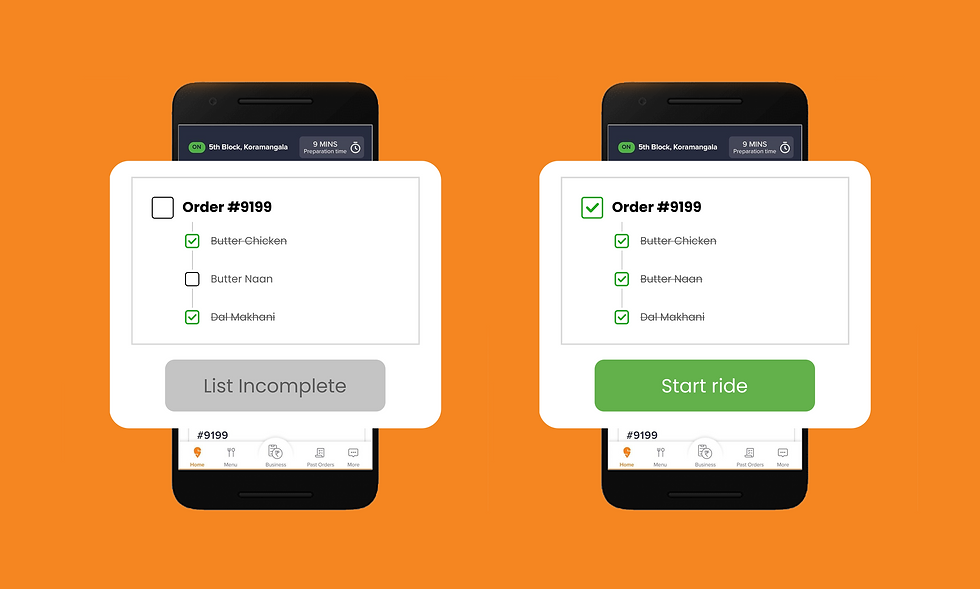Case study: How might we decrease missing item issues in food delivery apps? using Swiggy
- Mohammed Sannan
- Jun 8, 2021
- 3 min read
Updated: Jun 16, 2021
Have you ever had an item missing from your order and dealt with customer care for a refund? We are going to address this issue with the help of a Japanese method.

With restaurants closing dining options and adopting online ordering only, there has been a 50% increase in user adoption rate (in some tier 2 cities).
As the demand for online food ordering apps is at an all-time, there is also a challenge for food delivery apps to keep up with the demand and delivery the correct items. Usually, there is an item missing, or the wrong item is delivered altogether.

The restaurant does not deal with this issue. Delivery apps have to take the matter into their own hands and either refund the amount or redeliver the item to the customer.
I have also faced this issue at least once in every food delivery app and always wondered how I would address this issue. So this is going to be my take on this problem if I was a PM at Swiggy (Hypothetical)
Before proceeding, I must mention, not affiliated with Swiggy in any capacity, and the views for this article are strictly my own. Additionally, the improvements are suggested based on using hypothesis and observation.
For more insights on Swiggy's internal working:

User Journey:
User journeys are the step-by-step journey that a user takes to reach their goal. It is the experience a person has when interacting with something. The user journey is used to map out the current journey a typical user might take to reach their goal.

To understand the problem, we must look at the user journey of how food is dispatched and narrow down our focus.
We can see that the problem can arise only at the restaurant level. The user is powerless in this situation, can only hope the delivery agent gets the correct item.
Empathize
To understand the problem at its core, I talked with a Delivery Agent to get his perspective on the problem. Using open-ended questions like 'what problems do you face?', 'how should we address it?' to get his opinion. He mentioned if the order is ready before his arrival, in this situation, they're helpless and have to rely on the restaurant's words.
Usually, he'll check with the restaurant to make sure the contents are correct.
After understanding the key pain points, I would like to address the issue how I see fit.
How might we reduce items going missing from customers' orders?
We need to consider the following factors to know how an item is missed or misplaced at a restaurant:
1: The restaurant is experiencing a high order rate due to an offer and is getting flooded with orders. The kitchen staff is misplacing the items as the orders are piling up.
2: The delivery agent does not check the order before leaving the restaurant.
3: The order is ready even before the agent reaches the restaurant. Hence he/she was unable to review the contents.
Research
After researching how to increase efficiency, I stumbled upon a Japanese method of "pointing and calling" used by The Japanese railway system, also known as one of the best in the world.
A 1994 study by the Railway Technical Research Institute showed that pointing and calling reduced mistakes by almost 85 percent when doing a simple task.
Pointing and calling: This is a method in occupational safety for avoiding mistakes by pointing at important indicators and verbally calling out their status.
Workers who completed a simple task without pointing and calling made 2.38 errors per 100 actions, while workers who practiced pointing and calling made only 0.38 mistakes per 100 actions.
Source:

We can implement a modified version of "pointing and calling" to improve order handling efficiency. Delivery agents cannot be pointing at every item and call out a signal. But we could modify their behavior and making them more conscious with the help of a checklist.
New Features
A checklist with all the items, which lets the agent review, strike off the items in the list. The agent can only start if everything in the list is stricken off. It sounds too simple to work, right? Sometimes answers to complex solutions are simplistic never know how it'll work out.
Cons:
Agent ticking everything without reviewing.
Might lead to the mishandling of packed order.

Metrics
Performance metrics are figures and data collected and used to understand and improve an organization's services and products.

We will need to compare the number of complaints raised related to missing orders after the new feature. Obviously, if there is a significant decrease in missing order complaints, we can conclude that the experiment was a success.
Summary
Swiggy being a data-driven company religiously experiment with various strategies, we can expect that they'll make the best customer experience.
In the end, it is all about the trade-offs and coming up with the Goldilocks value.
PS: If there are any product problems you'll want me to work on as a case study, do reach out to me on Linkedin.




Comments